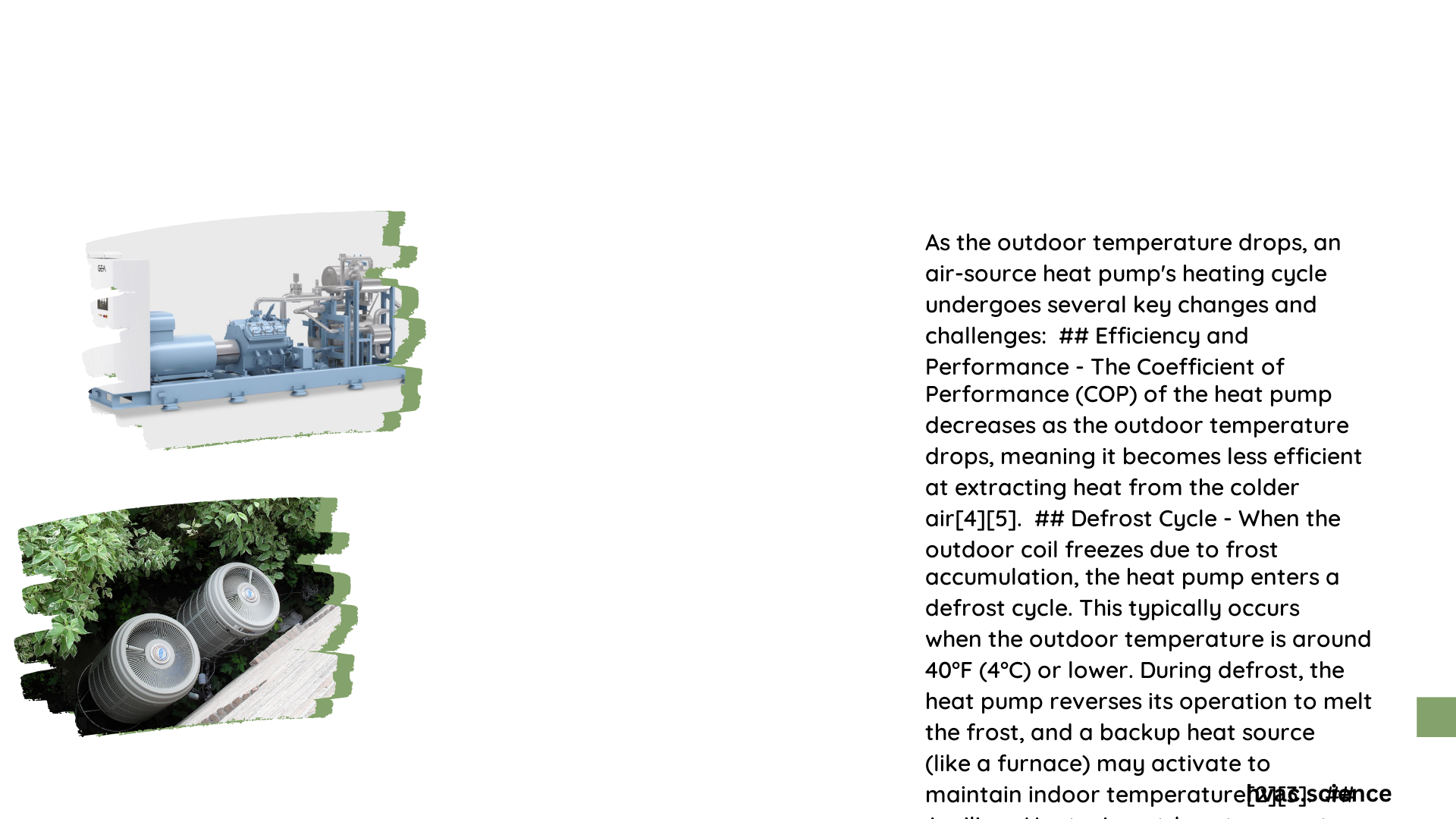An air source heat pump heating cycle as the outdoor temperature drops involves a complex interplay of efficiency, defrosting, and capacity adjustments. As temperatures fall, heat pumps work harder to extract heat from the colder air, leading to decreased efficiency and increased energy consumption. The system adapts by initiating more frequent defrost cycles and reducing overall heating capacity to maintain operation in challenging conditions.
How Does an Air Source Heat Pump Heating Cycle Change as Temperatures Drop?
An air source heat pump’s heating cycle undergoes significant changes as outdoor temperatures decrease. These changes affect the system’s efficiency, operation, and overall performance. Let’s explore the key aspects of this process.
What Happens to Efficiency Ratings at Low Temperatures?
As outdoor temperatures drop, the efficiency of air source heat pumps, measured by the Coefficient of Performance (COP), decreases. However, even at low temperatures, they often maintain higher efficiency than traditional heating systems.
- At 20°F (-7°C): COP ranges from 2.5 to 3.0
- At 10°F (-12°C): COP drops to 1.8 to 2.8
- At 0°F (-18°C): COP further decreases to 1.4 to 2.0
These values indicate that even in cold conditions, heat pumps can produce more heat energy than the electrical energy they consume.
How Does the Defrost Cycle Operate in Cold Weather?
The defrost cycle becomes a crucial part of the heating process as temperatures drop:
- Frequency: Defrost cycles occur more often, typically every 30-60 minutes.
- Duration: Each cycle usually lasts 5-15 minutes.
- Trigger: Defrosting is initiated when the outdoor coil temperature falls below a certain threshold, often around 32°F (0°C).
- Impact: During defrost, heating output temporarily decreases, potentially causing a short-term drop in indoor temperature.
What Reductions in Heating Capacity Occur at Different Temperatures?
As outdoor temperatures fall, the heating capacity of air source heat pumps decreases:
| Temperature | COP Range | Heating Capacity Reduction | BTU Output (% of Maximum) |
|---|---|---|---|
| 25°F (-4°C) | 2.5 – 3.0 | 20-30% | 70-80% |
| 15°F (-9°C) | 1.8 – 2.8 | 30-40% | 60-70% |
| 5°F (-15°C) | 1.4 – 2.0 | 40-50% | 50-60% |
How Does Temperature Drop Impact Overall Performance?
The relationship between temperature drop and heat pump performance is inverse:
- Lower outdoor temperatures increase the thermal gradient between indoor and outdoor environments.
- More energy is required to transfer heat from colder air to maintain indoor comfort.
- This results in lower COP values and reduced heating capacity.
- At temperatures above 32°F (0°C), ASHPs can maintain COPs of 3 to 6.
- Below 0°C, the COP decreases significantly, with major drops occurring below -10°C.
What Strategies Do Heat Pumps Use to Adapt to Cold Temperatures?
Air source heat pumps employ several strategies to maintain operation in cold conditions:
- Variable Speed Compressors: These allow the system to adjust its output based on heating demand and outdoor temperature.
- Enhanced Vapor Injection: This technology improves heating capacity and efficiency at low temperatures.
- Dual Fuel Systems: Some heat pumps work in conjunction with a backup heating source for extremely cold conditions.
- Optimized Defrost Cycles: Advanced control algorithms minimize the impact of defrosting on heating performance.
How Do Cold Climate Heat Pumps Differ from Standard Models?
Cold climate heat pumps are specifically designed to operate efficiently in lower temperatures:
- They often have larger outdoor coils to extract more heat from cold air.
- Enhanced compressor technology allows for operation at lower temperatures.
- Some models can operate efficiently at temperatures as low as -13°F (-25°C) or lower.
- They typically have higher HSPF (Heating Seasonal Performance Factor) ratings.
What Maintenance is Crucial for Heat Pump Performance in Cold Weather?
To ensure optimal performance during cold weather:
- Regularly clean or replace air filters.
- Keep the outdoor unit clear of snow, ice, and debris.
- Schedule professional maintenance before the heating season.
- Ensure proper insulation and sealing of the home to reduce heat loss.
- Consider installing a wind baffle to protect the outdoor unit from harsh winds.
How Can Homeowners Optimize Heat Pump Operation in Cold Climates?
To get the most out of an air source heat pump in cold weather:
- Set the thermostat to a consistent temperature rather than frequent adjustments.
- Use zoning systems to heat only occupied areas of the home.
- Supplement with other heat sources during extreme cold spells if necessary.
- Ensure proper sizing of the heat pump for the specific climate and home.
- Consider using programmable or smart thermostats for efficient temperature management.
By understanding how an air source heat pump heating cycle changes as outdoor temperatures drop, homeowners and HVAC professionals can better manage and optimize these systems for efficient operation in cold climates. While efficiency does decrease in extreme cold, modern heat pump technology continues to provide effective heating even in challenging winter conditions.
References:
1. Understanding Heat Pump Efficacy in Extreme Cold Weather Conditions
2. Study proves heat pump efficiency at low temperatures
3. Measured Performance of a Low Temperature Air Source Heat Pump

